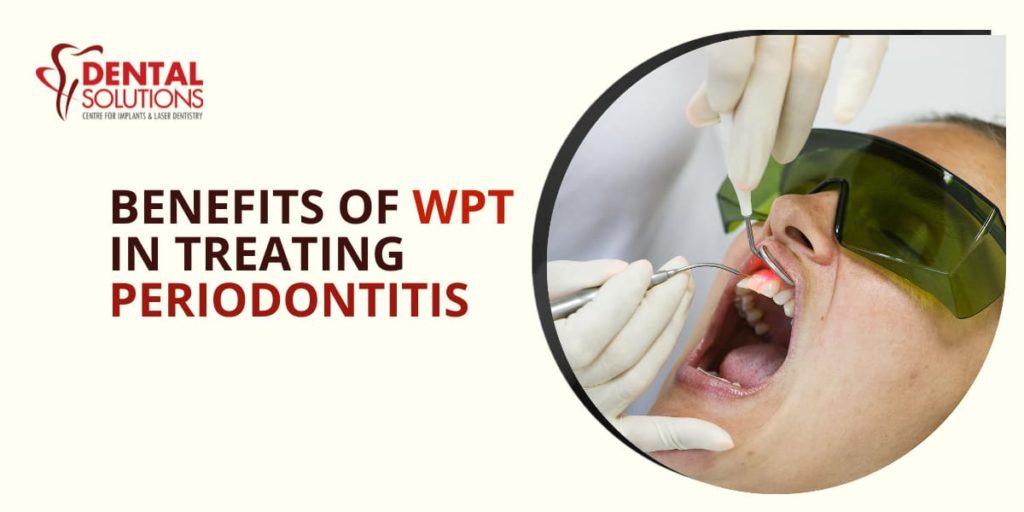- +917892951808
- Indiranagar, Bangalore
Best Dental Clinic In Bangalore Indiranagar | Best Dentist in Bangalore Indiranagar
- Home
- About Us
- Treatments
- Blog
- Contact Us
Benefits of WPT in treating Periodontitis – Wavelength optimised periodontal therapy

What is Wavelength optimised periodontal therapy?
Wavelength optimised periodontal therapy or WPT is a minimally invasive method to treat periodontal diseases using Nd: YAG and ER: YAG laser energy. These two wavelengths having unique clinical and therapeutic abilities are used to treat periodontal diseases in the most effective way. Instead of a sharp knife that would peel off the gum or teeth, thin laser quartz is inserted between the tooth and the gum line to remove the diseased tissue.
What is Periodontitis ?
Periodontitis is a severe gum infection that can lead to tooth loss and other severe oral and overall health complications. Periodontitis is also known as advanced gum disease. This serious gum disease damages the soft tissue and, if left untreated, can destroy the bone that supports your teeth. The causes or risks of periodontal diseases could be many – such as poor oral health, genetic, chronic illnesses like diabetes, smoking or chewing tobacco, and certain medications, plaque on your teeth, hormonal changes, for example, related to pregnancy or menopause and many more such reasons.
How is periodontitis treated?
Treatments are categorised into Surgical and Non-surgical. Typical non-surgical treatment for periodontal disease is scaling and root planing (SRP). Scaling removes tartar and bacteria from tooth surfaces and from underneath the gums. It may be performed using instruments, a laser or an ultrasonic device. Root planing levels the root surfaces, and stops the further buildup of tartar and bacteria and kills bacterial byproducts that are known to contribute to inflammation and slow healing.
In the surgical method, we have the traditional practice of Flap surgery (pocket reduction surgery). In this the periodontist makes small incisions in the gum so that a section of gum tissue can be elevated back, exposing the roots for more effective scaling and root planing. Since periodontitis often causes bone loss, the underlying bone may be recontoured before the gum tissue is put back in place after suturing. This method can be more painful and hence people look for alternatives.
The advent of lasers has been extremely beneficial, especially in periodontology, providing fast, simple, and highly effective treatments. Laser treatment is a tissue-preserving, regenerative, and bone-building procedure. Wavelength Er:YAG and Nd:YAG dental lasers are the ideal tools for performing the widest variety of laser-assisted periodontal procedures in a minimally invasive, cost-effective method.
In the surgical method, we have the traditional practice of Flap surgery (pocket reduction surgery). In this the periodontist makes small incisions in the gum so that a section of gum tissue can be elevated back, exposing the roots for more effective scaling and root planing. Since periodontitis often causes bone loss, the underlying bone may be recontoured before the gum tissue is put back in place after suturing. This method can be more painful and hence people look for alternatives.
The advent of lasers has been extremely beneficial, especially in periodontology, providing fast, simple, and highly effective treatments. Laser treatment is a tissue-preserving, regenerative, and bone-building procedure. Wavelength Er:YAG and Nd:YAG dental lasers are the ideal tools for performing the widest variety of laser-assisted periodontal procedures in a minimally invasive, cost-effective method.
How Does Wavelength optimised Periodontal Therapy work?
Wavelength optimised Periodontal Therapy is carried out in 4 simple steps:
1. The Nd: YAG laser destroys the diseased epithelial lining of the periodontal pocket and improves access to the root surface.
2. The Er: YAG is used to remove microbial biofilm and calculus from the root surface.
3. The Nd: YAG laser energy is used to harden and helps to form a stable fibrin clot. This seals off the pocket and promotes healing and bone regeneration.
4. Lastly, endotoxins from the root surface and epithelial lining are removed.
1. The Nd: YAG laser destroys the diseased epithelial lining of the periodontal pocket and improves access to the root surface.
2. The Er: YAG is used to remove microbial biofilm and calculus from the root surface.
3. The Nd: YAG laser energy is used to harden and helps to form a stable fibrin clot. This seals off the pocket and promotes healing and bone regeneration.
4. Lastly, endotoxins from the root surface and epithelial lining are removed.

What are the Benefits of WPT or Wavelength optimised periodontal therapy
- Reduced bleeding using Wavelength optimised periodontal therapy
People who have gingivitis or advanced gum disease suffer from extreme bone loss and gum bleeding. Therefore, it's crucial to eliminate bacteria from the teeth and gingival pockets. Lasers present the benefit of not only removing the bacteria but also destroying them completely. This helps reduce bleeding and inflammation of the gums. In some cases, it may even eliminate the need for further gum disease treatment such as gum surgery.
- Customised treatment depending on the severity
The wavelengths and the power levels of the laser beam can be modified or adjusted based on the varying levels of periodontal disease. This gives the dentist or the periodontist complete control over the procedure and allows them to provide a dental treatment that is uniquely suitable for that particular individual patient and also focusing on the long-term requirements and eliminating the recurrence of gum disease.
- WPT needs lesser healing time
Compared to traditional flap surgery, WPT laser treatment causes lesser trauma to the gum, tooth, and surrounding areas, which means healing time is drastically reduced. Patients are known to recover much quicker and the whole process is also completed faster.
- Minimally Invasive
WPT is most widely used because it is minimally invasive. It also reduces the need for the use of drills or any other strongly invasive incision machine. This decreases the pressure that patients feel, which also means there's little or no need for anaesthesia. However, the need for anaesthesia varies from patient to patient. The overall effect is less pain and discomfort for patients. With insignificant discomfort, patients will feel less anxious and are more relaxed during the treatment.
- Minimizes risk of bacterial infection
Laser therapy helps in sterilizing the area well and deeply, thus eliminating and lowering the risk of bacterial infections. The WPT treatment can target the diseased areas precisely and accurately, also reducing the risk of gum disease in future.
To find out more,
https://www.youtube.com/watch?v=H4ADTbshtXI
At Dental Solutions, Bangalore, we have successfully treated patients having severe periodontitis with Wavelength optimised periodontal therapy. Here's one of our patient reviews
We are proud to be among the few dental clinics in Bangalore that offer laser dentistry along with other latest dental technologies. Our main aim of investing in the latest dental technologies is to make sure you get the best treatment, in the most comfortable and less painful method.
If you have been suffering from gum disease for a long time and have been looking for the best treatment for gum disease or periodontitis in Bangalore, book an appointment with our dental professionals and we will help you find the best solution and treatment.
